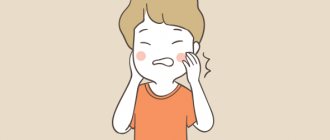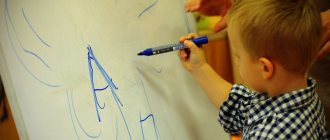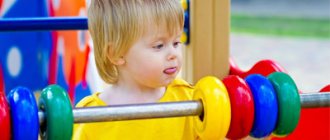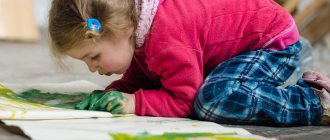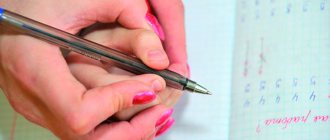Child development at 9 months - by the beginning of the ninth month, dramatic changes in the child’s behavior and development are noted. Not a trace remains of his chubby legs, arms and clumsiness. He no longer looks like the little boy he used to be. Now he is distinguished by curiosity, mobility and the desire to explore a new and interesting world around him. The baby spends a lot of time crawling and playing. It becomes easier for the mother, since she does not need to constantly carry the child in her arms; now she just needs to put the baby in a playpen or on a development mat and keep him in sight, while simultaneously going about her business and communicating with him.
The development of a nine-month-old baby is more aimed at strengthening the muscular and skeletal system.
They continue to intensively improve in order to prepare the toddler’s body for upright walking. Active psychological development is also observed, preparing the baby to utter the first words that parents so expect from him. [Hide]
Physical development of a child at 9 months
Since the baby at the age of nine months becomes very active, he begins to gain less weight than before, when physical activity was minimal.
During the ninth month, the baby will gain weight from 300 to 500 grams and grow from 1 to 2 centimeters. By the end of the month, the child’s parameters will be as follows. Weight will be from 8.5 to 9.5 kilograms, and height from 69.5 to 72.5 centimeters.
Norm of physical parameters
A monthly visit to the pediatrician is important for the entire first year of life. The specialist measures the main physical indicators and evaluates them. Using the table, you can find out whether the child’s physical development at 9 months meets the standards developed by WHO.
| Indicators | boys | girls | ||||
| Height, cm | Weight, kg | Head circumference, cm | Height, cm | Weight, kg | Head circumference, cm | |
| Very low | 65,2 | 6,4 | 41,2 | 62,9 | 5,8 | 39,8 |
| Short | 67,5 | 7,1 | 42,5 | 65,3 | 6,5 | 41,2 |
| Below the average | 69,7 | 8,0 | 43,7 | 67,7 | 7,3 | 42,5 |
| Average | 72,0 | 8,9 | 45,0 | 70,1 | 8,2 | 43,8 |
| Above average | 74,2 | 9,9 | 46,3 | 72,6 | 9,3 | 45,2 |
| High | 76,5 | 11,0 | 47,5 | 75,0 | 10,5 | 46,5 |
| Very tall | 78,7 | 12,3 | 48,8 | 77,4 | 12,0 | 47,8 |
Skills and abilities of a child at 9 months
A nine-month-old child sits independently and can remain in a sitting position for up to 10 minutes. When sitting, he can reach and play with toys.
The baby can stand up and hold onto the support for a while. He walks well in a walker and can walk holding onto a chair, slowly moving it forward. While the child can only walk for a short time, after a few more months he will be able to walk without support, increasing the walking time to half an hour. The child likes to jump and squat while in a crib or playpen. The baby crawls well. True, he is still doing this on his belly, since crawling on all fours is still difficult for him. If your baby isn't very good at crawling, there's no need to worry. It is enough to do special exercises with him that will not only help develop crawling skills, but will also allow you to consolidate them in practice.
A nine-month-old child uses the pinching technique, that is, he grabs objects of interest first with two or three fingers, and only then with his entire palm. At this stage, the child’s fine motor skills are improving, he tries to touch everything and stick his fingers wherever possible, as he experiences genuine interest in literally everything he sees. The child can already tear paper into pieces and confidently hold toys or other objects in his hands. This could be food, a cup, a spoon, etc. The baby can clench his fingers without difficulty, but he still has problems unclenching them. For this reason, if a toddler grabs an object, it will be very difficult to take it away from him. When parents try to take a held object away from a child, parents will be met with denial, pushing away their hands, and crying.
At nine months of age, your baby is still teething, and some babies are just starting to. This process is accompanied by moodiness, nervousness, increased temperature and drooling. There is no need to worry if your teeth have not yet begun to cut. They may appear a little later and be cut out immediately in pairs from above or below.
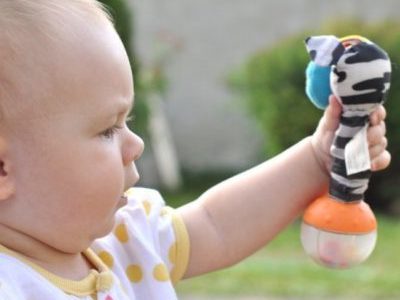
How to play with your baby?
Properly selected educational games are of great importance. A nine-month-old baby actively explores the world and is interested in everything in the world. Therefore, you can offer your child educational games involving both familiar and unfamiliar animals, birds and insects. When the baby has mastered this information, you can offer him educational games on everyday life. Today there are wonderful “talking” educational games on sale, thanks to which the baby absorbs information faster and better.
Excursion games are no less useful. You can not just walk your baby, but turn every walk into exciting games in the fresh air. It will be very interesting for the child to see in person what he met at home.
Games that develop fine motor skills are very useful. The nine-month-old baby loves to play with acorns, buttons and pebbles. It is important to remember that such games may be unsafe for the baby. He can easily put a small object that interests him into his mouth or nose.
What toys can you offer your baby? Children's toys should be varied in texture, color and shape. The nine-month-old baby loves not only to feel unfamiliar objects, but also to throw them and tear them to pieces.
Particular attention should be paid to such wonderful toys as pyramids and cups. What exactly should the cups be? First of all, these toys must have carved and smooth edges. In addition, they must be of different colors.
Nine-month-old babies are fascinated by nesting dolls. These touching toys are a real aid for the development of thinking, memory and attention. With the help of this toy, the baby disassembles the whole into several parts and learns to put one object into another.
Toys that promote the development of creative thinking are of great importance. Therefore, parents should pay attention to toys such as blocks.
Both boys and girls can be given moving toys. Don't ignore musical toys. With their help, you can develop your baby's ear for music.
Psycho-emotional development of a child at 9 months
The speech of a nine-month-old baby is developing rapidly, just as before. He repeats syllables, linking them into short words that he associates with objects or people. At this age, children often speak their first words.
The baby may change his intonation when communicating with his parents. He knows his name and answers it animatedly, turning his head, rejoicing and smiling. At nine months, the baby’s emotional background becomes definite. When they make him laugh, he laughs and rejoices, and when they scold him, he gets offended, angry or cries.
The toddler can point his finger at the objects that his parents tell him about. He asks to be brought to a closet or refrigerator so that he can get the thing he is interested in from there. He may also ask to take the toy out of his pocket if he sees that his parents put it there. The child can approach or crawl up to adults if they call him, and also take objects indicated by him. Fulfilling such simple requests for a nine-month-old baby is no longer as difficult as it used to be.
The baby has practically mastered such gestures as “yes” and “no”. He helps his mother dress himself, sticking his head into the neckline, his arms into the sleeves, and his legs into the trouser legs. He takes off his socks, rompers and hat.
The baby holds the cup with both hands and drinks from it, and takes food with two fingers. When playing hide and seek, he understands where the adult is, even if he does not see him. He can detect mom or dad by rustling sounds or voices.
While most toys are not used by the child for their intended purpose. He likes to hit them together, put one inside the other, throw them and watch them fall.
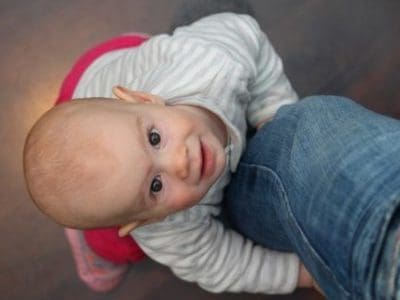
How to evaluate the indicators?
Approximately one in ten babies will have parameters outside the average statistical range, and for him this will be the norm. Why? It's simple - the head girth, weight and height of a child at 9 months, as at any other stage of development, are mainly influenced by the hereditary factor. Therefore, experts not only compare the baby’s parameters with the table, but also evaluate his general condition and heredity (height and weight of mom and dad, their nationality). If the baby’s parameters are in the range “below average - above average”, physical indicators are normal. The numbers obtained during the measurement, located in the interval zones “very low - low” and “very high - high” are not a reason for panic, but a reason for adequate consultation with a specialist. The weight and height of a child at 9 months also depend on the gender of the baby. The norm for boys is slightly higher than for girls.
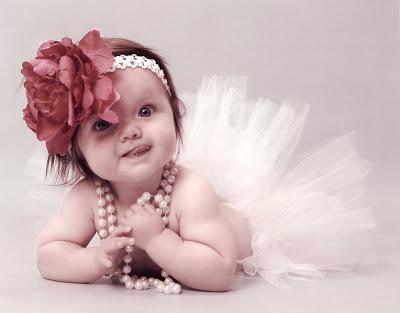
Assessing baby parameters is important for monitoring health and identifying malnutrition. For example, intense weight loss for no apparent reason may indicate various diseases, and increased weight gain may indicate an incorrect nutritional diet. But a rapid increase or decrease in the circumference of a child’s head indicates certain pathologies. One of these serious disorders is intracranial pressure.
Baby development test at 9 months
- A child at nine months should be able to sit without parental support, try to stand up on his own, crawl for toys, hold a glass or mug with both hands, and grasp objects with two fingers.
- In a position on the stomach, the baby should reach for the object of interest and crawl towards it. When sitting, the baby should be able to turn and grasp an object from the side or behind him.
- The child must imitate the gestures and actions of adults. If you show him any simple individual actions, he will be able to repeat them.
- If you try to take a toy away from a baby, he will hold it tightly, push away the adult’s hands and pull it towards himself, expressing dissatisfaction.
- The speech of a nine-month-old toddler should contain repeating syllables.
- The baby must respond to his name, and also distinguish people close to him from strangers.
If the baby lacks at least one of the skills listed above, he should be shown to a doctor who will confirm or deny the developmental delay.
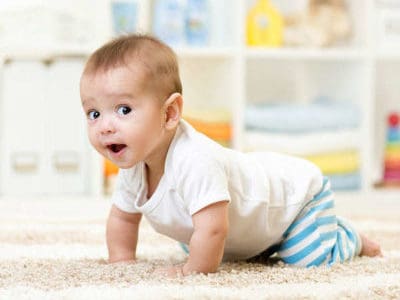
Language for the elite
By 9 months, most children have developed normal language (sounds plus gestures). Parents understand this language well, strangers do not. That's when the experience that you accumulated month after month, deciphering your baby's signals, came in handy. Certain sounds made by a child mean certain requests. Our Matthew said “mum-mum-mumm” when he wanted to be held. Let's look at some of the most common combinations of gestures and sounds. Pointing finger Babies begin to touch an object by lightly touching it (young mothers touch their babies in about the same way at first). At first, children touch the object only with their fingertips, and then touch it with an open palm. As the child begins to point with his finger at an object of interest to him, he begins to understand your pointing gestures. From Martha's diary: “About 6 months Matthew began pointing at our cat. First, he approached the unsuspecting cat with an open palm and splayed fingers. He carefully touched her head with the tip of his index finger, seemed to study the cat for a while with the tips of his other fingers, then put his entire palm on the cat’s head and finally grabbed it by the fur and squeezed it into a fist.” Invitation to the game. Take a closer look at what gestures and sounds the baby invites you to play. When you enter the room, the child really comes to life. His face lights up, a smile blooms, the baby waves his arms and reaches out to you with his whole body, as if saying: “Let's play!” Sounds that express mood. See how your baby expresses pleasure and disappointment. When he is happy, this radiant mood is expressed by a whole set of facial movements: the eyes shine, the facial muscles are tightened, the cheeks are parted with a smile. He laughs with a squeal and jumps up and down, his whole body radiating delight. At the same time, he makes joyful sounds - something like “ba-ba-ba-ba.” When a baby is sad, he mutters something sadly, grunts and makes growling, plaintive sounds. At this stage, the universal sound “n” means a variety of negative emotions. So, a child may protest against taking medication, whining protractedly “na-na-na-na.” The baby's face becomes unhappy: the mouth curls in a whiny grimace, the facial muscles fall off. And if you don't quickly figure out what's going on, crying will soon be heard.
Baby's diet at 9 months
If the child is still breastfed, he should continue to be breastfed, introducing new foods into complementary foods. Breast milk or formula should make up ¼ of a child’s daily menu at this age.
If complementary feeding was introduced at six months, then by this age three feedings should be replaced with regular food, and the child’s menu should contain the following products:
- Vegetable puree 180 grams;
- Fruit puree 80 grams;
- Porridge 180 grams, meat 50 grams;
- Yolk ½ part twice a week;
- Cottage cheese and kefir 40 grams;
- Wheat bread or cookies 5 grams;
- Butter and vegetable oil 5 grams each;
- Juice 80 grams;
- Fish 50 grams.
Cottage cheese diluted with kefir should be given to the baby before bedtime. From the beginning of the ninth month, you can give your baby steamed meatballs made from lean meat. You can puree several types of vegetables and add greens to it.
Porridges can also consist of several grains. If the child tolerates oatmeal and wheat porridge well, they are also introduced into the diet. It is better to refuse semolina porridge for now, as it is too heavy for the baby’s stomach. It should be introduced starting from one and a half years.

Sleep-wake schedule
At nine months old, the baby sleeps twice a day for two hours. The toddler's night rest is 10 hours. The rest of the time he is awake. By nine months, some children's daytime routine changes. This happens because the child begins to sleep longer at night and wake up later, as a result of which daytime sleep shifts slightly. But not everyone experiences such changes. Most babies play and sleep in the same way as before.
Those children who are breastfed wake up at night and ask to be fed. However, they do this not because they want to eat, but because they need psychological closeness with their mother. This behavior will continue until the woman weans the baby. In addition, infants at this age may experience sleep problems.
They are connected with the fact that children deliberately stretch the time allotted for wakefulness as they want. They are already clearly aware of when it is day and when it is night. They also understand well that people sleep at night and lead active lives during the day. To stabilize the child’s routine, you should clearly distribute the hours of sleep and wakefulness and ensure that he does not get overtired during games.

Parental help
Even if it is no longer as easy to carry a nine-month-old baby in your arms as before, parents should continue to do so. Before the child begins to walk independently, carrying in the arms is a mandatory factor influencing the correct psycho-emotional development.
It is necessary to continue to improve speech skills. You need to talk more with your baby, read books to him and look at bright pictures. With him it is necessary to learn short poems and nursery rhymes that have repetition of phrases, syllables and words in the context. When looking at pictures of a toddler, they must be discussed, asking him to show certain objects that are depicted there. For this purpose, you can use thematic cards with pictures.
You also need to pay a lot of attention to crawling skills and do everything to improve them. You need to roll the baby blanket into a roll and push it under the baby's chest. Then it should be lifted by the ends of the blanket to help the baby crawl to the toys. When the baby crawls, you need to create alternate support for his legs. This technique will help him master cross crawling faster. If the child has already mastered this skill well, he can buy a house with a tunnel. The baby will be delighted with such a toy and will begin to independently move from the house to the tunnel and back. You can also make such a toy from cardboard boxes.
Parents should show their child how to build towers from blocks or build a pyramid. Although the baby will not yet be able to imitate adults, it will be very interesting for him to watch the process. He can try to stack cubes on top of each other or put pyramid rings on a stick, thus improving his skills and abilities. After the tower is built, the child must be asked to destroy it. At the age of nine months, babies really enjoy this activity and they love to watch how objects fall and crumble. When the tower is destroyed, parents should ask the baby to put the cubes in a box.
Getting to know the world around you
From the age of nine months, a child should begin to be introduced to toilet paper. First you need to show how to unwind a roll. The child will really enjoy tearing it, crumpling it and scattering it around. This warm-up is very useful for developing fine motor skills. You can also attach a piece of tape to your toddler’s hand and ask him to tear it away from you. Such activities will also cause delight.
Regardless of the gender of the child, he needs to purchase a doll and the more similar it is to a real baby, the better. Parents should put the baby doll on a high chair and ask the child to show which part of the toy’s body is, voicing each of them independently. After this, you need to ask the baby to show all the listed parts of the doll’s body on himself.
Child development during play
You should not stop playing while taking a bath.
You need to show your child how to pour water from one glass to another. It is necessary to pour semolina into a large bowl and bury small objects in it, inviting the child to find them by rummaging in the cereal. For the baby you need to make a separate box and put objects from different materials there so that he can develop his tactile sensations. However, it should be remembered that all of them must be safe for the little one.
You need to continue playing “Ladushki” with your child, including funny and catchy children’s songs during the game. At nine months, the baby can already crawl and sit well, for this reason all previously performed exercises should be complicated by adding exercises with gymnastic equipment: plastic rings, balls and wooden sticks.
You need to communicate with a nine-month-old baby while playing. This is very important to him. Care should be taken to ensure that each room has a safe set of objects that can be given to the child to play with. Parents can come up with their own entertainment for the baby or ask him what he would like to play. By his actions they can understand what exactly he wants. It is necessary to allow the child to start the game first, so he can be taught to be independent and responsible for his decisions.
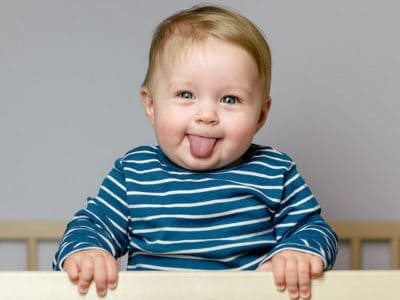
Vertical position
The nine-month-old fidget hardly sits in one place, so it requires constant attention from its parents. The development of a child at 9 months brings new achievements: he not only crawls, but already stands on his feet, holding onto support, and even tries to stand without it. The first time this can happen spontaneously. But, having appreciated the new skill, the baby will not stop at the success achieved. The inquisitive little one really likes the vertical position. By the end of the month he will most likely be able to stand up without support.
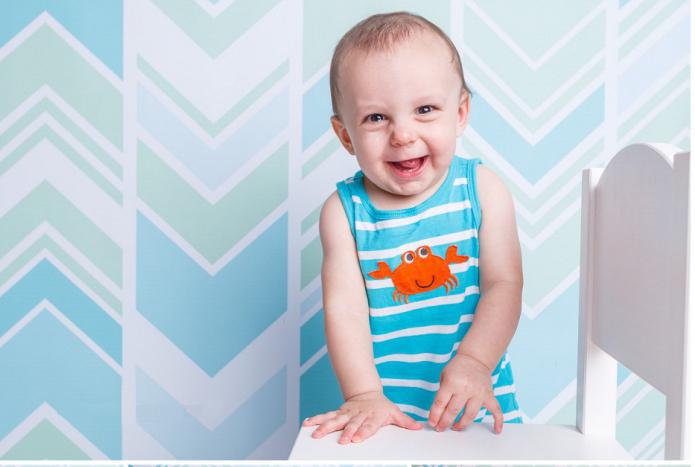
A nine-month-old baby can move around the playpen by holding onto the bars with his hands. You can help your baby explore a larger territory. To do this, you need to arrange the position of the furniture so that when moving the baby always has something to hold on to. Mom should remember to be careful, so when creating an area for the baby, think through all the potential dangers. It is necessary to exclude objects and things that can cause injury or harm to the little fidget: household appliances, sharp corners, vases, chemicals, and so on.
